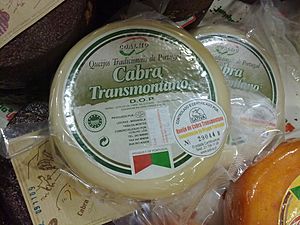Queijo de Cabra Transmontano facts for kids
Queijo de Cabra Transmontano is a special type of cheese made from goat milk. It comes from the beautiful mountains of Alto Trás-os-Montes in the northern part of Portugal. This cheese has a special label called a Protected designation of origin (PDO), which means it can only be made in this specific area following traditional methods. It is also listed on the Ark of Taste, a list of important foods that are worth protecting.
Contents
What Makes This Goat Cheese Special?
Queijo de Cabra Transmontano is known for its unique taste and texture. It can be found in different forms, from soft and fresh to hard and aged. The cheese gets its special qualities from the local goats and the way it is made.
Protected Designation of Origin (PDO)
The "Protected Designation of Origin" (PDO) label is like a special badge for food. It tells you that a product, like this cheese, comes from a specific place and is made using traditional steps. This label helps protect the quality and reputation of the cheese. It also ensures that only cheese made in Alto Trás-os-Montes, following strict rules, can be called Queijo de Cabra Transmontano. This helps customers know they are getting the real thing.
Listed on the Ark of Taste
The Ark of Taste is a list created by an organization called Slow Food. It includes foods from all over the world that are unique and important to local cultures, but might be at risk of disappearing. By being on this list, Queijo de Cabra Transmontano is recognized as a valuable part of Portugal's food heritage. This helps people learn about it and encourages its continued production.
Where Does Transmontano Goat's Cheese Come From?
This cheese is made in the Alto Trás-os-Montes region of northern Portugal. This area is known for its rugged mountains and traditional farming. The climate and plants in this region are perfect for raising goats, which produce the milk needed for the cheese.
The Goats of Trás-os-Montes
The goats that provide the milk for this cheese are often local breeds, well-adapted to the mountain environment. They graze on natural pastures, eating wild herbs and grasses. This diet gives their milk a special flavor, which then passes into the cheese. Farmers in this region have been raising goats and making cheese for many generations.
How Is Transmontano Goat's Cheese Made?
Making Queijo de Cabra Transmontano is a traditional process that has been passed down through families. It involves several steps, all done carefully to create the perfect cheese.
From Milk to Curd
First, fresh goat's milk is collected. It is then gently warmed. A natural ingredient called rennet is added to the milk. Rennet helps the milk separate into solid curds and liquid whey. The cheesemakers then cut the curds into small pieces.
Shaping and Salting
The curds are placed into special molds, which give the cheese its shape. They are often pressed to remove more whey. After shaping, the cheeses are salted. Salting adds flavor and helps preserve the cheese.
Aging the Cheese
Finally, the cheeses are left to age in cool, well-ventilated rooms. This aging process can last for several weeks or even months. During this time, the cheese develops its unique flavor, aroma, and texture. Younger cheeses are softer, while older ones become firmer and have a stronger taste.
Enjoying Transmontano Goat's Cheese
Queijo de Cabra Transmontano can be enjoyed in many ways. Younger, softer versions are great for spreading on bread or adding to salads. Older, firmer cheeses can be sliced and eaten on their own, or used in cooking. It is a delicious way to experience a taste of Portugal's traditional food culture.
See also
 In Spanish: Queso de cabra transmontano para niños
In Spanish: Queso de cabra transmontano para niños


